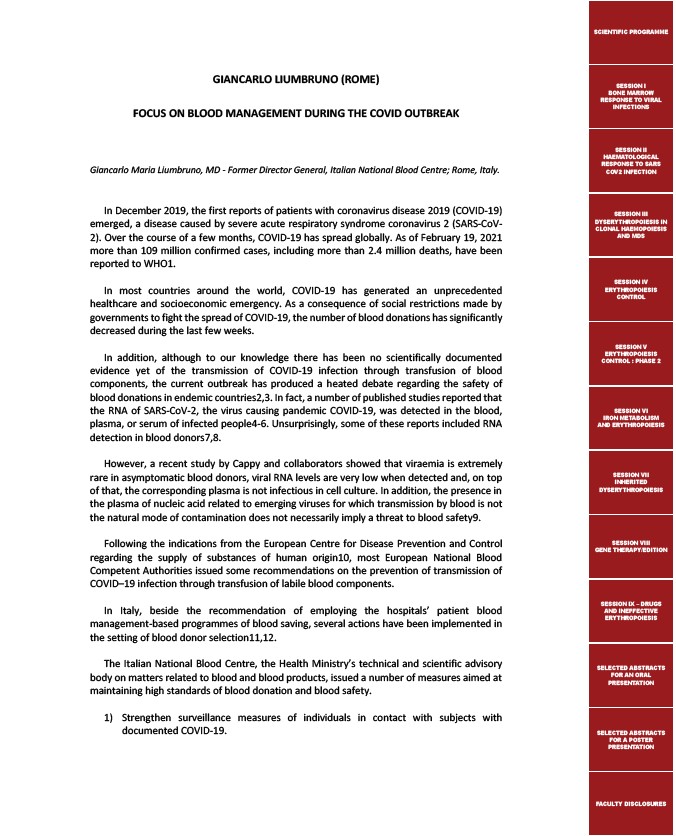
GIANCARLO LIUMBRUNO (ROME)
FOCUS ON BLOOD MANAGEMENT DURING THE COVID OUTBREAK
Giancarlo Maria Liumbruno, MD - Former Director General, Italian National Blood Centre; Rome, Italy.
In December 2019, the first reports of patients with coronavirus disease 2019 (COVID-19)
emerged, a disease caused by severe acute respiratory syndrome coronavirus 2 (SARS-CoV-
2). Over the course of a few months, COVID-19 has spread globally. As of February 19, 2021
more than 109 million confirmed cases, including more than 2.4 million deaths, have been
reported to WHO1.
In most countries around the world, COVID-19 has generated an unprecedented
healthcare and socioeconomic emergency. As a consequence of social restrictions made by
governments to fight the spread of COVID-19, the number of blood donations has significantly
decreased during the last few weeks.
In addition, although to our knowledge there has been no scientifically documented
evidence yet of the transmission of COVID-19 infection through transfusion of blood
components, the current outbreak has produced a heated debate regarding the safety of
blood donations in endemic countries2,3. In fact, a number of published studies reported that
the RNA of SARS-CoV-2, the virus causing pandemic COVID-19, was detected in the blood,
plasma, or serum of infected people4-6. Unsurprisingly, some of these reports included RNA
detection in blood donors7,8.
However, a recent study by Cappy and collaborators showed that viraemia is extremely
rare in asymptomatic blood donors, viral RNA levels are very low when detected and, on top
of that, the corresponding plasma is not infectious in cell culture. In addition, the presence in
the plasma of nucleic acid related to emerging viruses for which transmission by blood is not
the natural mode of contamination does not necessarily imply a threat to blood safety9.
Following the indications from the European Centre for Disease Prevention and Control
regarding the supply of substances of human origin10, most European National Blood
Competent Authorities issued some recommendations on the prevention of transmission of
COVID–19 infection through transfusion of labile blood components.
In Italy, beside the recommendation of employing the hospitals’ patient blood
management-based programmes of blood saving, several actions have been implemented in
the setting of blood donor selection11,12.
The Italian National Blood Centre, the Health Ministry’s technical and scientific advisory
body on matters related to blood and blood products, issued a number of measures aimed at
maintaining high standards of blood donation and blood safety.
1) Strengthen surveillance measures of individuals in contact with subjects with
documented COVID-19.
SCIENTIFIC PROGRAMME
SESSION I
BONE MARROW
RESPONSE TO VIRAL
INFECTIONS
SESSION II
HAEMATOLOGICAL
RESPONSE TO SARS
COV2 INFECTION
SESSION III
DYSERYTHROPOIESIS IN
CLONAL HAEMOPOIESIS
AND MDS
SESSION IV
ERYTHROPOIESIS
CONTROL
SESSION V
ERYTHROPOIESIS
CONTROL : PHASE 2
SESSION VI
IRON METABOLISM
AND ERYTHROPOIESIS
SESSION VII
INHERITED
DYSERYTHROPOIESIS
SESSION VIII
GENE THERAPY/EDITION
SESSION IX – DRUGS
AND INEFFECTIVE
ERYTHROPOIESIS
SELECTED ABSTRACTS
FOR AN ORAL
PRESENTATION
SELECTED ABSTRACTS
FOR A POSTER
PRESENTATION
FACULTY DISCLOSURES